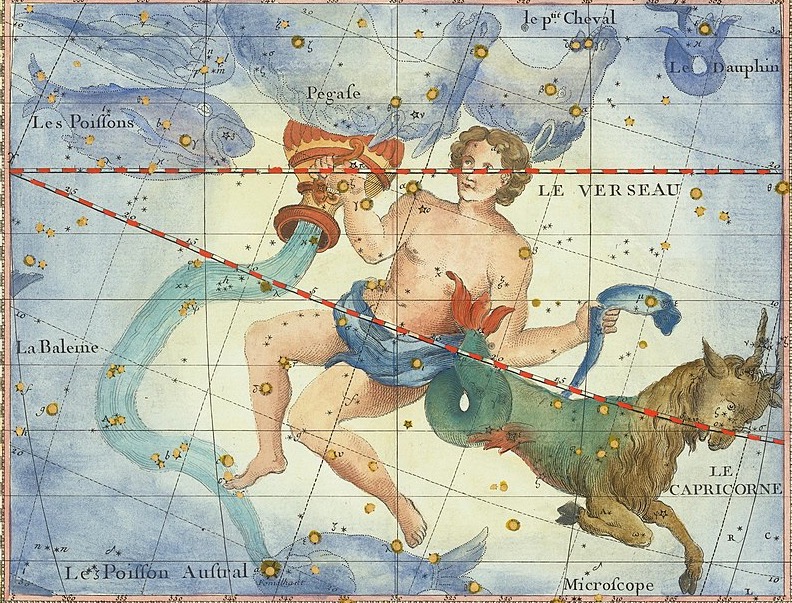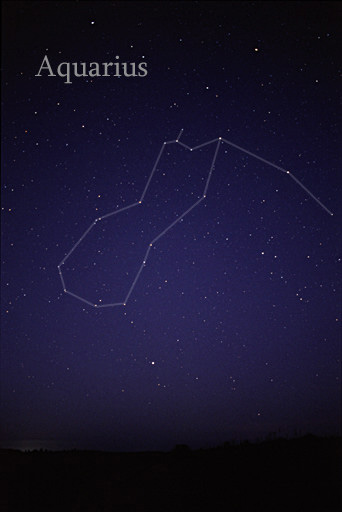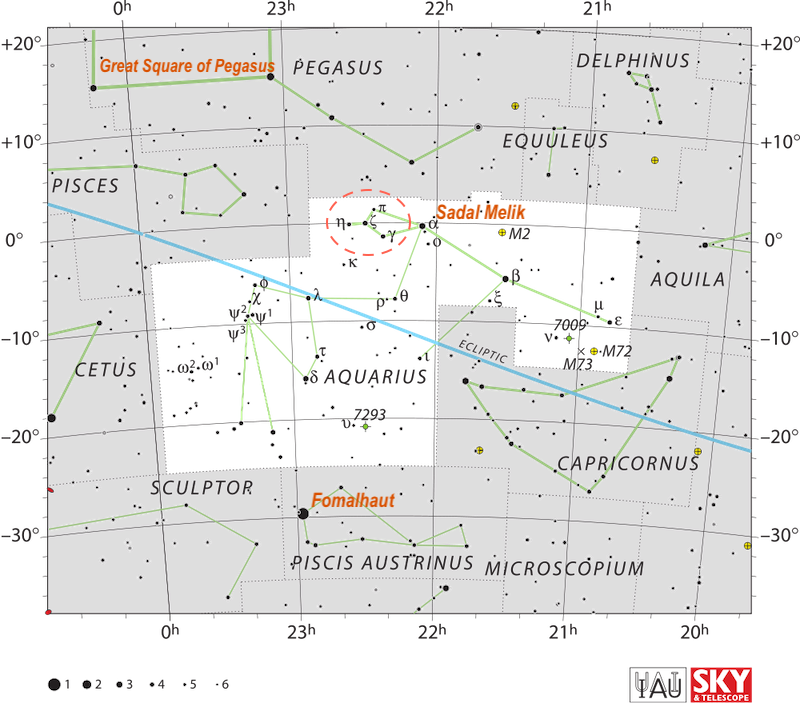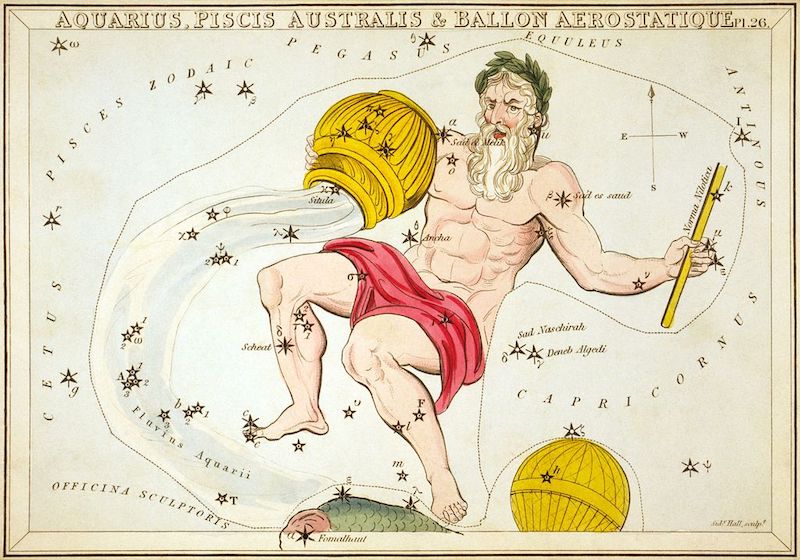

A star chart, from M. J. Fortin’s Atlas Celeste de Flamsteed, published 1776, showing Capricornus and Aquarius. In the dark sky, the “water” pouring from the Water Jar of Aquarius is the most noticeable part of this constellation. It’s a zig-zag line of stars. Image via Barry Lawrence Ruderman Antique Maps/ Wikimedia Commons.
Lying on our sky’s dome between the constellations Capricornus and Pisces, Aquarius the Water Bearer can be tricky to pick out. There aren’t many bright stars in this constellation, and you’ll need a dark sky to get a good look of it. It’s one of the 12 constellations of the zodiac, though, and that means the sun, moon and planets occasionally or regularly pass within its boundaries. It was a special constellation to the early stargazers for this reason. It can be special to you, too – for its beauty and its lore – if you learn to find Aquarius on the sky’s dome.
The 2021 lunar calendars are here! Order yours before they’re gone. Makes a great gift!
How to see the constellation Aquarius
Aquarius is best seen in the evening sky during a Northern Hemisphere autumn or Southern Hemisphere spring. It’s just to the east of another zodiacal constellation, Capricornus. And you can use the Great Square of Pegasus to guide you toward Aquarius.
From northerly latitudes, this constellation appears in the southern sky. South of the equator, it’s found overhead or high in the northern sky. You’ll see Aquarius highest in the sky in early October around 10 p.m. local time (11 p.m. local daylight saving time in the U.S.), or one month later – in early November – around 8 p.m. local time (9 p.m. local daylight saving time in the U.S.).

An image of the constellation Aquarius with lines drawn to connect its faint member stars. The brighter star at the bottom center is Fomalhaut. Image via Till Credner/ Wikimedia Commons.
Aquarius is located in a region of the sky sometimes called the Sea. This part of the sky looks dark and deep, but of course there are stars here, as there are everywhere on the heavenly globe. The stars in this part of the sky tend to be faint. In western sky lore, early stargazers associated the star patterns here with water in a celestial sea. It’s here we find Cetus the Whale, Pisces the Fish, Eridanus the River, and Piscis Austrinus the Southern Fish.
The brightest star in this “watery” region of the sky is Fomalhaut in Piscis Austrinus the Southern Fish. Aquarius the Water Carrier is usually portrayed as a man pouring a stream of water into the mouth of the Southern Fish, which is interesting since fish don’t drink water. In the sky, you’ll see a zig-zag line of stars leading from Aquarius to Fomalhaut, the only bright star in the celestial Sea. By the way, because it’s in such an apparently empty part of the sky, Fomalhaut is sometimes called the Loneliest Star.
If your sky is dark enough, you can see a little asterism – or noticeable pattern of stars within Aquarius — just to the left of the star Sadal Melik. This little pattern, shown within the orange dashed oval in the star map, is called the Water Jar in Aquarius. Imagine a cascade of faint stars as water, visible in very dark skies, making a zigzag stream of stars, flowing down toward the star Fomalhaut.

A map of the constellation Aquarius. The orange dashed oval region is the water jar asterism – compare those stars to the ones drawn in the water jar in the Urania’s Mirror Aquarius the Water Bearer illustration. Stars under the water jar asterism could be imagined as water pouring from the jar into the mouth of Piscis Austrinus, where Fomalhaut represents the Southern Fish’s mouth. Image via IAU/ Sky & Telescope/ Wikimedia Commons.
Dates of sun’s passage through Aquarius
As seen from Earth, the sun passes in front of the constellation Aquarius from about February 16 to March 12. It is important to note that these dates are in reference to the constellation – not the sign – Aquarius. The sun is in the sign Aquarius from about January 20 to February 18. (A constellation of the zodiac refers to certain section of the starry sky. On the other hand, a sign of the zodiac refers to the seasonal position of the sun, irrespective of what constellation backdrops the sun at a given season.)
Aquarius in history and star lore
This ancient constellation has been associated with water throughout the Old World. But whether the abundance of water was regarded as a blessing or a curse seems to depend upon geography.
Greek mythology associates Aquarius with the deluge that wiped out all of humanity except for Deucalion and his wife Pyrrha. Zeus, king of the gods, unleashed the flood to punish people for their misdeeds and advised the virtuous Deucalion to save himself by building an ark. This tale of divine retribution strongly parallels the story of the great flood in the Old Testament.
In ancient Egypt, the constellation Aquarius represented Hapi, god of the Nile River. This benevolent god distributed the waters of life, and the urn symbolized a fount of good fortune. It’s this association that explains why the Water Bearer is often seen holding the Norma Nilotica – a rod for measuring the depth of the Nile River. Also, the names of Aquarius’ two brightest stars – Sadalmelik and Sadalsuud – reaffirm the idea of providence. The names are thought to mean lucky one of the king and luckiest of the lucky.

Hapi, god of the Nile, depicted on a limestone slab from the temple of Thutmose III in Koptos, Egypt. Image via Osama Shukir Muhammed Amin/ Wikimedia Commons.

An illustration of Aquarius the Water Bearer from Urania’s Mirror, a set of astronomical star charts first published in 1824. The water jar contains a small pattern of stars known as the water jar asterism. Water is seen flowing from the jar towards Fomalhaut, mouth of the Southern Fish. Image via US Library of Congress / Wikimedia Commons.
Bottom line: Aquarius the Water Bearer is a faint zodiacal constellation, best seen in a dark sky.
Taurus? Here’s your constellation
Gemini? Here’s your constellation
Cancer? Here’s your constellation
Leo? Here’s your constellation
Virgo? Here’s your constellation
Libra? Here’s your constellation
Scorpius? Here’s your contellation
Sagittarius? Here’s your constellation
Capricornus? Here’s your constellation
Aquarius? Here’s your constellation
Pisces? Here’s your constellation
Aries? Here’s your constellation
Birthday late November to early December? Here’s your constellation
Source:
https://earthsky.org/constellations/aquarius-heres-your-constellation